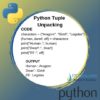

The Python interpreter confirms that the list_to_tuple_example variable contains a tuple: Convert a Dictionary to a TupleĪ Python dictionary is composed of a series of key-value pairs that are wrapped in curly braces. Use the type() function to display the list_to_tuple_example variable’s type.

list_to_tuple_example = tuple(example_list) In this article, I will cover the various ways to unpack Python lists and tuples. Unpacking can be done on iterables like lists, tuples, ranges, and dictionaries.

To convert example_list into a tuple, pass example_list as an argument of the tuple() method, and assign the result to a new variable. Unpacking means extracting those values into different variables, like color,shape,fruit a. In Python, a list contains comma-separated items wrapped in square brackets.
Tuple unpacking how to#
The following sections show you how to convert Python’s collection types into a tuple. Python collection types include lists, tuples, sets, and dictionaries. The tuple() function converts the four Python collection types into a tuple. The difference occurs because the first example includes a trailing comma, while the second example does not. The Python interpreter confirms that the day variable does not store a tuple, and instead stores a string: Now, store the same value in the day variable, but exclude the trailing comma. The Python interpreter confirms that day contains a tuple with a single value. Use the type() function to display the day variable’s type. For example, create the following tuple to store a single string. If you don’t include the comma, Python does not store the value as a tuple. To store a single value, or singleton in a tuple, you must include a comma when assigning the value to a variable. If you print example_tuple, the following is returned: print(example_tuple)Ĭreate a Tuple with a Single Value (Singleton) Use the built-in tuple() method to create a new tuple: example_tuple = tuple() You can exclude the parentheses when creating a tuple with multiple values: example_tuple = 1, 2, 3 Create a Python TupleĪ Python tuple can be created in the following ways:Ĭreate an empty tuple with an empty pair of parentheses: example_tuple = ()Ĭreate a tuple with multiple values that are separated with commas: example_tuple = (1, 2, 3) The section below covers the syntax for each way that you can create a Python tuple. However, there are a few syntax quirks to keep in mind when working with tuples in Python. Another way to think of this is that the tuple of values is unpacked into the variable names. The syntax to create a Python tuple is made up of your tuple values that are comma separated and enclosed in parentheses. Tuple Assignment with Unpacking Python has a very powerful tuple assignment feature that allows a tuple of variable names on the left of an assignment statement to be assigned values from a tuple on the right of the assignment. Moreover, this code's size increases by one line for each new value that we want keep in the tuple.Python 3.0 installed on your machine to follow along with the examples in this guide.

Tuple unpacking code#
The code is less unpleasant but the syntax is also less straightforward. ReSharper disable once CppDeclaratorNeverUsedĢ - I can store the whole tuple and use std::get to retrieve the reference to the only variables I need. However, the dummy variable will be unused and it will issue a warning, so if I want to silent that warning the code will be quite unpleasant to see: #pragma warning(push) Now, how can I proceed to store only b and c and to discard a?Ĭurrently, I'm only aware of two options:ġ - I can use a dummy variable when auto-unpacking In C++17, you can call the function and unpack the tuple in a single line: auto = foo() Let's imagine you need to call the following method: std::tuple foo()


 0 kommentar(er)
0 kommentar(er)
